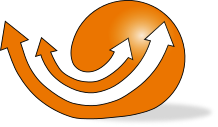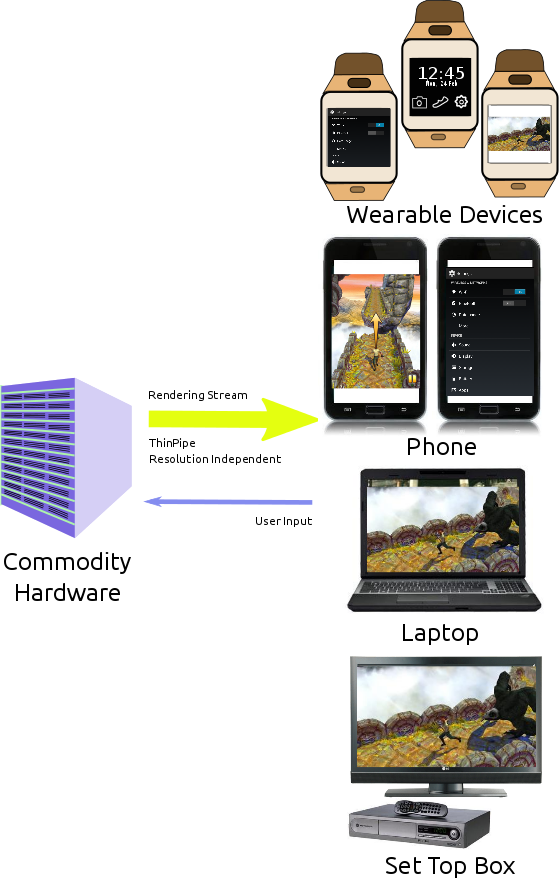

Remote Android:
Cloud Hosting, Wearable Devices and BYOD
Cloud Hosting, Wearable Devices and BYOD
Joel Isaacson
joel@ascender.com
+972 50.597.5146
kvm.ascender.com/wearable
+972 50.597.5146
kvm.ascender.com/wearable
Ascender’s technology extends the utility of Android apps, far beyond what was envisioned by their creators, in a cost and computer resource-efficient manner. The technology enables remote access to a large number of the over one million available Android apps while solving the problem of managing multiple systems and platforms. The application of our technology to Android Cloud hosting, wearable devices and multi-platform BYOD is discussed.
Android Android, with over 80% of the worldwide mobile phone market, is enormously successful. The Android API is very popular with developers and has high functionality. Whereas HTML5 can be used for writing applications that run on many different systems, it doesn’t seem to have blunted the number of native API apps being written. While there is much experience in Virtual Desktop Infrastructure (VDI) for Windows there is no comparable infrastructure for remote Android access.
Computing Software Computing systems are undergoing a period of upheaval as evidenced by the decline of the previously dominant PC systems, and the rise in mobile systems and the ChromeOS platform. Seemingly, the enterprise application mix will change over the next few years from the current Windows mono-culture to a mix of Windows, Android, IOS and HTML5. Such a change necessitates a strategic reassessment of current capabilities and approaches.
Computing Hardware The mix of deployed computing platforms is also in flux. The wide adoption of mobile platforms, both phones and tablets, the decline of desktop systems, and the rise in the use of ChromeOS platforms have been widely reported. The recent interest in wearable devices is quite intense, though their ultimate adoption rate is still unknown.
Problem: Divergence With the end a single computing system dominating the industry, a strategic approach in this multi-system era is called for. The current proliferation of systems and hardware platforms leads to inefficiencies as applications need to be developed for multiple platforms. It would be advantageous to develop for one platform and reuse this application on all other platforms.
Solution: Convergence The Android API is a natural choice to become the standard for writing applications. The large number of developers who can write Android apps is a driving force for its adoption.
-
Benefits of Ascender’s Solution
- Enables cost and computer resource efficient remote execution of Android apps on multiple platforms.
- Viewable on the remote client without performance compromise.
- Enables remote access to a large number of the over one million available Android apps.
- Provides a high graphical frame rate using low network bandwidth.
- Solves the BYOD problem of managing multiple systems and platforms.
Select Use Cases
Android in the Cloud In this configuration the Android application is run in the cloud on a virtualized host as shown in Fig 2.
-
Cloud An unmodified Android app is installed in the Android virtual image running in the cloud. The state of this system is persistent.Remote The remote client can be from a wide range of systems: Windows, Chrome OS, OS X, Android, IOS, Tizen, etc. The remote client can be from a wide range of platforms: desktops, laptops, tablets, phones or wearable devices. No state information is preserved on the client between remote sessions, resulting in strong data security and allowing for the use of stateless clients such as Chrome OS.
Wearable Devices In this configuration, Fig. 1, devices that are being carried on the person, or are in close proximity to the person, communicate. The wearable device might have constraints of computational power, network connectivity and/or OS comparability that will make it difficult to run a desired application.
-
Mobile Device This is a device running the Android OS. It might be a tablet or phone.Wearable Device This might be a device connected to the mobile device via a low bandwidth connection such as Bluetooth. The OS runnning on the wearable device might be unable to run Android applications. Ascender’s technology allows the use of Android apps on devices that can not natively run these applications.
Mobile Enterprise Devices It is very common for an enterprise to adopt a BYOD policy. While being convenient for both the enterprise and employee, its adoption causes support problems for an enterprise having to contend with a large number different mobile platforms. Mobile device management (MDM) is a difficult challenge in an environment with many different devices. Ascender’s remote Android technology greatly simplifies supporting a wide range of devices.
-
Cloud The applications can be written once, for Android only. They can be run in the cloud under the control of the enterprise. Hosting in the cloud intrinsically solves many security problems.Mobile Device The Android applications can be viewed on a wide range of platforms: desktops, laptops, tablets, phones and even wearable devices. Security is simple to provide since the data resides in the enterprise cloud. The responsibility for the mobile device management rests with the employee since the enterprise data security management is done in the cloud.
Other Use Cases Potential uses for Ascender’s technology are:
-
- Cloud gaming
- App Library / Subscription Model
- Set-Top Boxes
- Automated Testing
- WebGL Browser Based Implementations
Links:
- Main repository on the technology and FAQ.
- Remote Android rendering
- The Challenge of Mobile Devices in the Enterprise
- On The Convergence of Chrome OS and Android
- Remote WebGL Demo

Figure 1: Android Phone to Wearable Devices

Figure 2: Cloud Based Remote Android Graphics